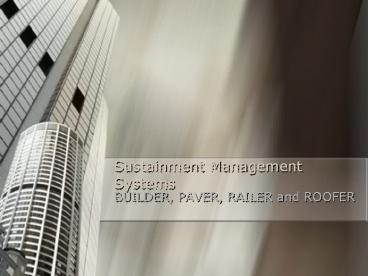Sustainment Management Systems - PowerPoint PPT Presentation
1 / 14
Title:
Sustainment Management Systems
Description:
Title: Sustainment Management Systems Author: Lance Marrano Last modified by: Lance Marrano Created Date: 8/9/2006 7:30:12 PM Document presentation format – PowerPoint PPT presentation
Number of Views:132
Avg rating:3.0/5.0
Title: Sustainment Management Systems
1
Sustainment Management Systems
- BUILDER, PAVER, RAILER and ROOFER
2
Condition Index Development
- Condition Assessments and Indexes focused on
component level - BUILDER Roof Membrane, Air Handling Unit,
Overhead Door - PAVER Airport taxiway, apron, city block
- RAILER Turnout, Grade Crossing, Ties
- ROOFER Entire Roof Section
3
Expertise in a Box
- Condition Indexes developed by interviewing a
panel of experts to get a statistical agreement
on how defined defects result in a rating (0-100)
of the assets condition. - Results in a system which incorporates experts
experience in objectively rating asset condition
using observed distresses.
4
Condition Prediction
- BUILDER 3.0 incorporates a new condition
prediction engine based upon industry models of
failure probability distribution. - Using the Weibull cumulative probability
distribution function as the basis for condition
trend, condition history is used to adjust the
curve to the specific assets observed behavior.
5
Condition Prediction (cont.)
- Incorporates both distress survey (traditional
SMS inspection), and direct rating (quick red,
amber, green rating) methods - Affects of repairs are modeled.
- Patent currently applied for this method under
COE-582CIP
6
Work Identification - Standards
- Work is automatically generated by looking for
components which dont meet a required condition
level. - Standards define both minimum condition levels
for work (resulting in repairs) and minimum
levels of reliability (expressed in remaining
service life and resulting in replacement).
Condition Index Definition
100 Entire component-section or sample free of observable defects
99-93 No component-section or sample serviceability or reliability reduction.
92-86 Slight or no serviceability or reliability reduction overall to component-section.
85-75 Component-section serviceability or reliability is degraded but adequate.
74-65 Component-section serviceability or reliability is definitely impaired.
64-56 Component-section has significant serviceability or reliability loss.
55-37 Significant serviceability or reliability reduction in component-section.
36-11 Severe serviceability or reliability reduction, such that it is barely able to perform.
10-0 Overall degradation is total.
7
Work Identification - Policies
- Policies define how standards are applied to
inventory. - Policies defined upon the criticality,
consequences of failure and level of risk you are
willing to accept for various types of inventory
(i.e. building use type, system, importance of
facility, tenant requirements, etc.) - Policy sequences allow for multiple criteria on
each asset, with overriding preference - Work is created by rules, based upon objective
data, rather than subjectively based upon skill,
knowledge, and preferences of observer
8
Work Identification - Prioritization
- Prioritization is used to rank work requirements
- Use various parameters including economic,
criticality, and geographic factors - Effectively target work to most important items
by cost and criticality to mission accomplishment.
9
Work Identification - Summary
- Work is automatically created based upon
objective rules and acceptable levels of risk
(expressed as condition). - Work costs are derived automatically as a
parameter of the condition. - Work is prioritized based upon user-specified
criticality and financial metrics and weighted
according to user business practices. - Unfunded work (based upon priority) is added to
backlog, and FCI is automatically calculated. - Condition Prediction models can be applied in
simulation to develop multi-year work plans for
strategic and tactical planning.
10
IMPACTIntegrated Multi-year Prioritization
Analysis Consequences Tool
- Simulation tool to allow user to vary standards,
policies, prioritization, inflation, funding,
uses, and real property inventory to determine
effects of various facility management decisions.
11
Mission Focused Facility Investments
- Objective Equitably distribute facility
investments to assure mission accomplishment and
greatest cost effectiveness. - Method
- Utilize METL information to organize and define
hierarchy of tasks. - Identify facility characteristics required to
support mission - Physical Attributes (Site, size, footprint, etc)
- Spaces (Changing the use of interior areas)
- Components
- Compare mission facility requirements against
facility performance - Capability (measured by functionality)
- Serviceability Reliability (measured by
condition) - Identify options for closing gaps
- Track building performance and its impact on
mission
12
SMS Current Status
- BUILDER
- Used by USMC, DoE, FBI, and many private
organizations. - BUILDER 3.0 is new web-based version with support
for entire enterprises. - PAVER
- Used by all DoD services, as well as FAA.
- New desktop release - PAVER 6.0
- RAILER
- Used by Army, Navy, and USMC. IMA performing
more implementations next year. - RAILER 6.0 is new version with redesigned user
interface and support for modern and future
operating systems. - ROOFER
- Used by Army and Navy.
- Development underway to upgrade to web-based
system based upon BUILDER application framework. - Joint SMS Users Group Meeting
- First meeting of multiple-program users to define
common development needs and standardize on
common work management practices using SMS
products.
13
- Questions?
14
About this Presentation
- Presenter Lance Marrano
- Engineer Research Development Center, CERL
- Phone 217-373-4465
- Email Lance.Marrano_at_us.army.mil































